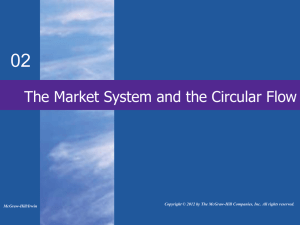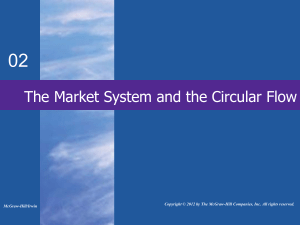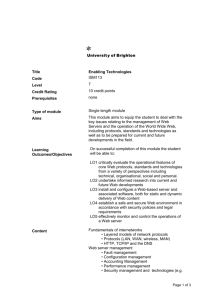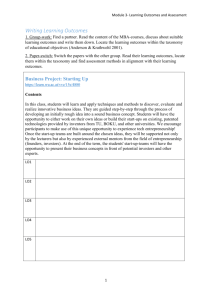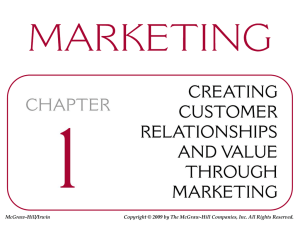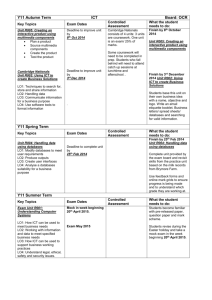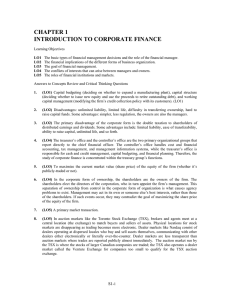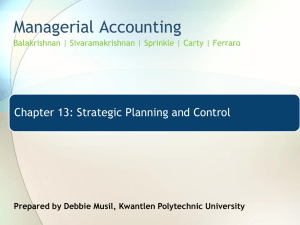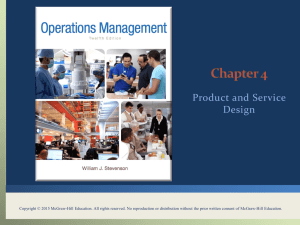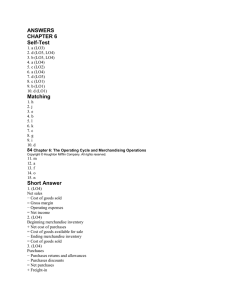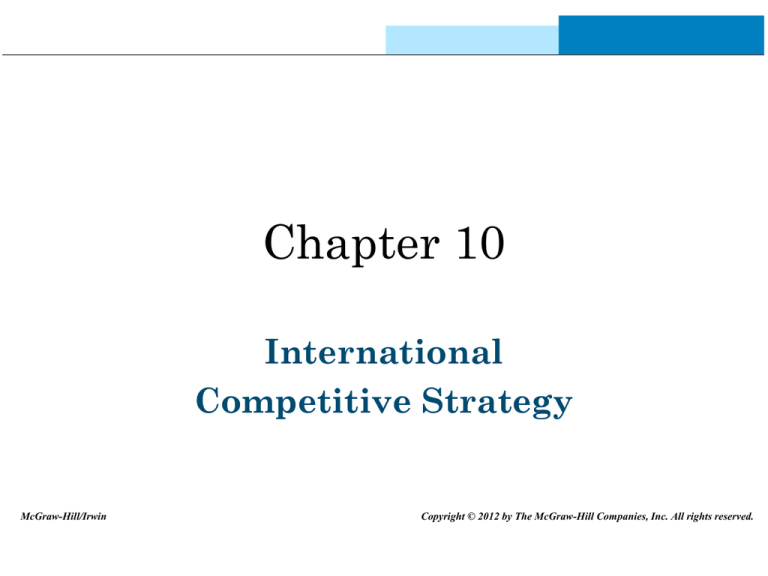
Chapter 10
International
Competitive Strategy
McGraw-Hill/Irwin
Copyright © 2012 by The McGraw-Hill Companies, Inc. All rights reserved.
The Competitive Challenge Facing
Managers of International Businesses
• Managers must
LO1
– quickly identify and exploit opportunities wherever
they occur, domestically and internationally
– fully understand why, how, where, and when to do
business in specific world markets
– know the company’s strategic mission, its strengths
and its weaknesses
10-2
LO1
What is International Strategy,
and Why is it Important?
• International
Strategy
– “the way firms make
choices about acquiring
and using scarce resources
in order to achieve their
international objectives”
• It involves
– decisions about which
markets to enter with which
products, when and how
– all the various functions and
activities of the company and
how they interact
– ensuring that strategy is
consistent across functions,
products, and regional units
– a variety of unique demands
associated with operating
internationally
10-3
LO1
What is International Strategy,
and Why is it Important?
• Goal of International
Strategy is to
maintain
Competitive
Advantage
– “the ability of a company
to have higher rates of
profits than its
competitors”
• Competitive
Competencies
– “skills or abilities to
adequately complete a task”
1. Create value for which s
customers will pay
2. Are rare – shared
competencies are no basis for
competitive advantage
3. Difficult to imitate or
substitute
4. Organized so company can
exploit and capture value
from competitive potential
10-4
LO1
Global Strategic Planning
• Why Plan Globally?
– To deal with
environmental forces
that are
• Complex
• Global
• Subject to rapid
change
• Strategic Planning
– “a process by which
an organization
determines where it is
going, how it will get
there, and how it will
assess whether and to
what extent it had
achieved its goals”
10-5
LO2
1.
2.
3.
4.
5.
6.
7.
Global Strategic Planning
Process
Analyze the company’s external environments,
Analyze the company’s internal environments,
Define the company’s business and mission,
Set corporate objectives,
Quantify goals,
Formulate strategies, and
Make tactical plans.
10-6
LO2
Global Strategic Planning Process
• Analyze Domestic,
International, and
Foreign
Environments
• Analyze Corporate
Controllable
Variables
1. Who are the company’s
target customers?
2. What value does the
company want to deliver
to these customers?
3. How will this customer
value be created?
10-7
LO2
Knowledge as a Controllable
Corporate Resource
• Knowledge Management
– “practices that organizations and their managers use for
identification, creation, acquisition, development, dispersion, and
exploitation of competitively valuable knowledge”
• Tacit Knowledge
– “knowledge that an individual has but that is difficult to express
clearly in words, pictures, or formulate and therefore difficult to
transmit to others”
• Explicit Knowledge
– “ knowledge that is easy to communicate to others via words, pictures,
formulate, or other means”
10-8
LO3
Define the Corporate Mission,
Vision, and Values Statements
• Mission Statement
– “a broad statement that defines the organization’s purpose and
scope”
• Vision Statement
– “describes the company’s desired future position if it can
acquire the necessary competencies and successfully
implement its strategy”
• Values Statement
– “ clear and concise description of the fundamental values,
beliefs, and priorities of the organization’s members
10-9
LO3
Set Corporate Objectives
• Objectives
– Direct the firm’s course of
action
– Maintain action within
the mission’s boundaries
– Ensure the mission’s
continuing existence
• To implement an effective
strategy quantifiable
objectives are important
• Intel’s Mission:
– “to delight our customers,
employees, and shareholders by
relentlessly delivering the
platform and technology
advancements that become
essential to the way we work
and line”
• Intel’s Objectives:
1. Extend leadership in silicone
and platform manufacturing
2. Deliver architectural for marketdriven platforms
3. Drive world-wide growth
10-10
LO3
Formulate the
Competitive Strategies
Quantify the Objectives
• Competitive Strategies
• International operations
deals with quantitative
& qualitative factors
• Difficult to quantify
• “What, how much,
when?” defines
objectives
• “How?” formulates
strategies
– “action plans the enable
organizations to reach
their objectives”
• Based on:
– external environmental
forces
– Internal SWOT Analysis
– Cost reduction
– Local market adaptation
offers 4 strategic
alternatives
10-11
LO4
LO4
Home Replication
Strategy
• Centralizes product development
functions in home country
• Developed products transferred
to foreign markets order to
capture additional value
• The company must posses a
distinctive competence local
companies lack
• Headquarters maintains tight
control over marketing &
product strategy
• Subsidiaries leverage home
country capabilities
Multidomestic Strategy
• Used when there is strong
pressure for local market
adaptation
• Decentralized decision making
allows for quick change
• Leads to increased cost structure
• Excessive adaptation may take
away from product’s
distinctiveness
• Cost and complexity of
coordination can be high
10-12
LO4
LO4
Global Strategy
Transnational Strategy
•
•
•
•
•
•
•
•
•
Used when company faces strong
pressure to reduce costs with limited
pressure for local market adaptation
Strategy and decision making
centralized
Company offers standardized
products and services
Value chain activities are in only one
or a few geographic areas
Subsidiaries send information to HQ;
HQ imposes centralized controls
Limited ability to adjust to local
customer needs
Higher transportation and tariff
costs for exporting product
Risk in locating activities in
centralized location
•
•
•
•
Used when facing simultaneous
pressures for cost effectiveness and
local adaptation
Assets and activities located where
most beneficial for the firm
Subsidiaries contribute to developing
firm’s overall capabilities
– “Upstream” value chain
activities will be more
centralized
– “Downstream” activities
localized closer to customers
Achieving optimal balance is
challenging
Strategic decisions, structures, and
systems are complex
10-13
LO4
Standardization and Planning
• Not all firm’s activities confront the same mix of
globalization and localization pressures
• R&D and manufacturing are standardized and
coordinated world-wide
• Top Execs feel marketing strategies are best
determined locally
• Desire for some degree of marketing strategy and total
product standardization
• Execs realize that change will occur and must be
factored into strategic plans!
10-14
LO4
Contingency Plans
Scenarios
• Scenarios
– “multiple, plausible stories
about the future”
• Assesses implications of various
economic conditions & operating
strategies
• “What if” scenarios let managers
challenge assumptions and
projected outcomes of different
strategies
• Assists with “decision making
under uncertainty” and rapidly
change changing international
conditions
• Contingency Plans
– “ plans for the best- or
worst-case scenarios or for
critical events that could
have a severe impact on
the firm”
• Based on “be prepared…crisis
will happen” view
• Ensures effective communication
and continuation of operations in
the event of crisis
10-15
Strategic Plan Features and
Implementation Facilitators
LO4
Sales Forecasts &
Budgets
Plan Implementation
Facilitators
• Sales Forecast
• Policies
– “a prediction of future
sales performance”
• Budget
– “itemized projection of
revenues and expenses for
a future time period”
– “broad guidelines to assist
lower –level personnel I
handling recurring issues
or problems”
• Procedures
– “specialized ways
performing a particular
task or activity”
10-16
LO5
Methods of Planning
Top-down Planning
• “planning process that begins at the highest level in
the organization and continues downward”
Bottom-up Planning
• “planning process that begins at the lowest level in the
organization and continues upward”
Iterative Planning
• “ repetition of bottom-up or top-down planning
process until all differences are reconciled”
10-17
LO5
New Directions in Planning
• Traditional
Bureaucratic Form:
– Calendar-driven ritual done by
CEO and Head of Planning
– Handed down to operating
people for execution
– Ritualistic
– Devoid of discovery
– “Working from today forward
not future back assuming future
will be similar to present”
– Based on historical projections
– Outdated mind-sets on
competition
• Strategic
Management
• Who does Strategic
Planning?
• How Strategic
Planning is Done?
• Contents of the
Plan?
10-18
LO5
Strategic Management
Who does Strategic Planning?
• Diverse planning teams from all levels across all related business units
working in open collaboration; other stakeholders influence planning
How Strategic Planning is Done
• Ideas can surface anywhere/anytime; unsuitable tactics require
strategy change; bad strategies require new goals; shorter, less
structured plan documents
Contents of the Plan
• Focus on issues, strategies, implementation using creative, forwardlooking ideas needed for competitive success in changing global
environments with long-term perspective on decisions and resources
10-19
LO5
Summary
of the International Planning Process
For Flexibility to Compete Globally and Domestically:
1. Top management must assume a more explicit strategic decisionmaking role, dedicating a large amount of time to deciding how
things ought to be instead of listening to analyses of how they are.
2. The nature of planning must undergo a fundamental change from an
exercise in forecasting to an exercise in creativity.
3. Planning processes and tools that assume a future much like the
past must be replaced by a mind-set that is obsessed with being first
to recognize change and turn it into a competitive advantage.
4. The role of the planner must change from being a purveyor of
incrementalism to being a crusader for action and alter ego to line
management
5. Strategic planning must be restored to the core of line management
responsibilities.
Frederick W. Gluck, McKinsey & Company
10-20

